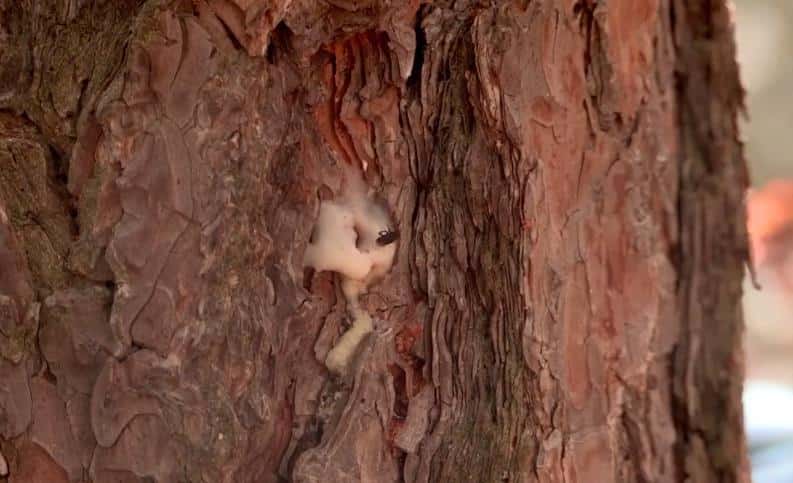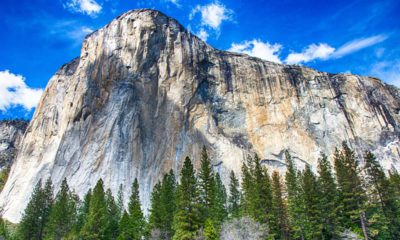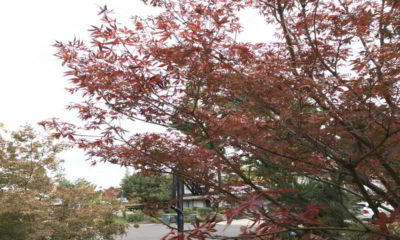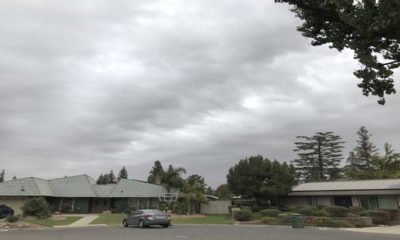Local
Sierra Club: Bark Beetle, Dead Trees Don’t Fan Wildfires, Problem Is Too Much Fire Suppression
Published
5 years agoon

As the Creek Fire continues to ravage the Sierra, the debate about how to prevent this type of fire again leads down divergent paths.
Cal Fire points to the 80%-90% tree mortality rate from bark beetle in the Creek Fire’s territory as a major contributing factor.
But Sierra Club California and the Center for Biological Diversity cite studies showing dead trees from bark beetle are no more flammable than other trees. Instead, they say, the problem is too much fire suppression and homes that interface with Mother Nature.
GV Wire℠ spoke to retired Socal Edison project manager John Mount. He counters that the two environmental groups are leaning on science that doesn’t take into account California’s unique topography. He also said that the studies cited weren’t based in the Sierra.
Sierra Club California

“There is a controversy about dead trees.” — Kathryn Phillips, Sierra Club California Director
Sierra Club California Director Kathryn Phillips told GV Wire℠ by phone the amount of fire suppression over the years has led to a large increase in trees in the Sierra Nevada.
“There is a controversy about dead trees,” said Phillips. She pointed to a 2013 study that concludes: “Most available evidence indicates that bark beetle outbreaks do not substantially increase the risk of active crown fire in lodgepole pine and spruce forests under most conditions.”
Phillips says the focus should turn from logging or mechanical thinning of forests and focus on defensible space around homes and cabins.
“I don’t see logging as a way to do this,” said Phillips. “Defensible space around homes of 100 feet, and hardening of homes with things like protective screens to prevent embers from getting into attics is what needs to be emphasized.”
She again pointed to the 2013 study. It states: “Once (bark) beetle populations reach widespread epidemic levels, silvicultural (practice of controlling growth) strategies aimed at stopping them are not likely to reduce forest susceptibility to outbreaks. Furthermore, such silvicultural treatments could have substantial, unintended short- and long-term ecological costs associated with road access and an overall degradation of natural areas.”
Studies: Dead Trees Don’t Impact Fire Severity

“Studies indicate that there is no effect of dead trees on different aspects of wildfire behavior including wildfire severity, rate of spread, or extent.” — Shaye Wolf, Climate Science Director Center for Biological Diversity
“Studies indicate that there is no effect of dead trees on different aspects of wildfire behavior including wildfire severity, rate of spread, or extent,” said Shaye Wolf. climate science director of the Center for Biological Diversity. “What Sierra Club California told you about dead trees being no more flammable is correct. In fact, it’s not just that 2013 study.”
She pointed to four other studies to support her position.
- Hart, S.J., et al., Area burned in the western United States is unaffected by recent mountain pine beetle outbreaks, 112 PNAS 14 (2015)
- Bond, M.L. et al., Influence of pre-fire tree mortality on fire severity in conifer forests of the San Bernardino Mountains, California, 2 The Open Forest Science Journal 41 (2009)
- Meigs, G.W., et al., Do insect outbreaks reduce the severity of subsequent forest fires? 11 Environmental Research Letters 4 (2016)
- Hart, S.J. & D.L. Preston, Fire weather drives daily area burned and observations of fire behavior in mountain pine beetle affected landscapes, 15 Environmental Research Letters 054007 (2020)
The Center for Biological Diversity’s website says the organization is “fighting a growing number of national and worldwide threats to biodiversity, from the overarching global problems of unsustainable human population and climate change to intensifying domestic sources of species endangerment, such as off-road vehicle excess.”

Shaye Wolf of the Center for Biological Diversity stands next to a “thinning” project off Highway 88 in California.
Wolf: Thinning Forests Leads to Faster Burning Fires
Wolf said that thinning the forests isn’t an effective way to protect communities from wildfires and it “can even make fires burn hotter and faster.”
Wolf said that the Creek Fire rapidly burned through areas that were recently logged (including the removal of large dead trees) under the claim that this would curb future wildfires.
“In fact, the logged areas are where the fire spread fastest,” Wolf said. “Dead trees — standing or fallen — provide important benefits such as wildlife habitat, soil stabilization, water quality, and carbon storage.”
She doesn’t see how logging could have prevented what’s happening in the Sierra National Forest.
“Forests with large numbers of dead trees (known as “snag forest”) support among the highest levels of biodiversity of any forest type. All these benefits are lost when dead trees are logged,” Wolf said.
She said that California should help communities retrofit homes with fire-resistant roofing, rain gutter guards, and ember-proof vent screens, along with pruning vegetation in the defensible space immediately surrounding homes.
“These are the most effective actions for wildfire safety, but they are getting the fewest resources from the state and federal government,” Wolf said.
Mount: Studies Are Deceiving

“Here’s the problem. … That’s firewood up there.” — John Mount, retired Socal Edison project manager
Mount doesn’t dispute the findings of the studies, but he noted that “all the studies were done in the Rocky Mountains. It’s totally different here in the Sierra.”
The studies defy common sense, he said.
“Here’s the problem. … That’s firewood up there,” Mount said. “The fire return interval here is five to 10 years. In the Rockies, it’s at least every 300 years.
“To compare the Rockies to the Sierra Nevada is ludicrous. Fire burns in the Rockies whether trees are green or dead.”
Mount said that he’s told Sierra Club members they’re using the studies out of context.
“I’ll guarantee you on my life this fire (Creek Fire) has burned hotter because of the dead trees,” he said.
Cal Fire: Bark Beetle Tree Mortality a Significant Factor
“So many of the trees have died creating significant fuel for the fire to burn,” said Cal Fire Public Information Officer Daniel Berlant in a video about the Creek Fire. “Massive amounts of pine trees that have died off over the years due to drought and due to the bark beetle.”
Berland cited a website showing the number of dead trees in parts of the Creek Fire with a “red” rating — indicating there are 15 to 40 dead trees an acre.
In an email to GV Wire℠, Berlant said, “The sheer number of dead trees all in close proximity plays a major role in fueling wildfires, and is absolutely a factor in why the Creek Fire was able to explode in size.”
What a Federal Official Says
Jim Hubbard is undersecretary for Natural Resources and Environment at the U.S. Department of Agriculture.
He told GV Wire℠ that studies cited by the environmental group are “in part correct” and trees killed by the bark beetle are less of a standing hazard.
But, said Hubbard, trees killed by the bark beetle present an additional hazard to firefighters and change the way they must attack the blazes.
“All of our trees in a drought situation with low fuel moistures are flammable,” he said.
You may like
-


Fresno’s George Whitmore, Legendary Climber of El Capitan and Conservationist, Dies at 89
-


They Made Fresno’s News in 2020. Who Is No. 1?
-


Sierra Ski Resort China Peak is Making Snow, Readies for Weekend Opening
-


High Wind and Blowing Dust Expected Valley-Wide Tuesday. Rain Expected Overnight.
-


Hail Falls in Fresno as Local Freeze Warning Continues
-


First Significant Storm of the Season Arrives Saturday. Creek Fire Area in Risk Zone.














Marie
September 10, 2020 at 3:30 pm
Ridiculous. They’re just covering their butts. If I were anyone that lost anything in these fires, I’d sue the state, Sierra Club and anyone else that had something to do with setting the current guidelines for “maintaining” the forests.
Jeremy
September 10, 2020 at 8:35 pm
Marie, U mean the Federal govt? These fires are happening on forest service land. Feds keep cutting budgets leading to deferred maintenance across all of our forest land. State has to pick up tab to fight these mega fires. How much good work could we do in our forests with just 1/10 the cost of putting out these fires???
Joe
September 12, 2020 at 10:28 am
Amen
Mike
September 10, 2020 at 8:14 pm
Thank you for an interesting review of the competing views. I’m wondering if Oregon, which has lots of logging and also lots of big fires, would be a better comparison than the Rockies? Did they also have the drought and beetle kill?
MICHAEL PISTORESI
September 11, 2020 at 6:21 am
The real problem here is our ignorant public officials and legislators who set policy based on this false science being presented by people who have not lived in these areas and seen that once forest management was curtailed by the “Junk science” espoused by these people with “too much money and too much time on their hands” that fires increased at an alarming rate. Why not stay in your own lane and worry about things that affect your life instead of meddling in other peoples lives? I would like to see how they would react if it was their house or livelihood that had just burned to the ground. Bet they would be singing a different tune.
P. Scizzle
September 13, 2020 at 11:15 am
Michael, do you expect the government to protect you no matter where you decide you want to build your house? If you build your house on top of a volcano, should the government find ways to stop volcanos from exploding? If you build your house on quicksand, should the government find ways to fight quicksand?
The same conservative leaning people who want government out of their lives and argue against government regulations want the government to come protect them from nature.
It doesn’t matter if you believe in science of not. Forrest and fires were here long before humans and they will continue to be here long after.
Where you decide to build your summer vacation cabin is of no concern.
Jim
September 11, 2020 at 8:24 am
Anybody that believes dead trees don’t burn faster than live ones can do a simple experiment. Throw a dead log in fire and then a live one and see which is consumed faster.
P. Scizzle
September 13, 2020 at 11:18 am
Jim, are there any live trees left standing in the wake of the fire? It looks like the live trees and the dead trees turned into the same burnt ash to me.
Maybe we can request that the government come in and remove all of the natural trees and replace them with non flammable plastic trees. That way people can continue to build their Air BnB rentals wherever they please.
Penny Lacy
September 11, 2020 at 8:57 am
Both the National Forestry folks and the Environmental groups have put us on the wrong path. Putting out every fire/fire suppression leads to thickening forests with too many trees, so does the Environmentalist groups desire to save every tree, dead or alive in the forest. The forests need to be thinned out through a return of some of the logging that used to be done and doing prescribed burns as the Indians used to do. What we have now is complete and utter destruction of the forests and everything that used to live there. Habitats not fit for animals, plants or people to live in or sustain life again…..just smoldering grey ash everywhere.
P. Scizzle
September 13, 2020 at 11:22 am
What makes you think that the aftermath of a forrest fire is inhabitable to animals or plants? Forrest fires are part of the natural renewal process for forrest life.
Where thousands of acres of trees stood dead due to bark beetle infestation (caused by human driven climate change), new healthy trees will grow.
Granted the time scale of nature and the forest don’t match up with People’s desire to build their dream cabins in the woods.
You’ll be long dead, but the forrest will still be there.. more “fit” than ever for the plants and animals.
Mark Mansfield
September 11, 2020 at 9:57 am
The last two replies are absolutely correct. Anyone 50 yrs old+ and has been in California would tell you, When Logging was active in our State and the Forest service managed this process through private Contractors, Wild fires such as the ones we have experienced over the past few years were far and few. Common Sense would tell anyone that raw fuel burns. Pour gas on the dirt and it will ignite. Years of not managing our beautiful forest has created this issue. In some ways, the Sierra Club is correct. Fire burns the dead brush and downed Trees and cleans up the Forest. Now go back 30 years. Loggers bid on lumber. Forestry would designate the trees to be cut. These private Contractors, “Loggers” would pay the State to cut and remove these selected trees and as part of the agreement, The loggers would also be responsible to clean up the dead and dying under brush that existed in that area. The loggers would also work with the State and conduct controlled burns at a time when the ground and air had enough moisture to safely burn and create very little issues to our air quality. Then Came the Spotted Owl, The Sierra Club and others that felt as if they were much smarter than those who actually knew what needed to be done to prevent the issues we face Today. What will it take for the Great People Of this Beautiful State to Stand up and say enough is enough! State Officials should be held accountable for pushing their agendas based on who funds their Campaigns. These same officials should be held accountable if they fail to base their Actions and Decisions on Facts and Science as well as History. Seems as if I have heard some of these same Elected officials make that very same Statement Recently. This Nov. we have the right to remind them who they work for!
Jeff
September 11, 2020 at 10:25 am
I read the 2013 paper and looked at the abstracts of the others. There is a lot of detail there, and room for debate, but it does seem that insect infestation is not as big a driver of forest fires over years and across different landscapes as weather, drought (climate), total fuel, and forest structure.
In terms of what we can manage to reduce fire risk, forest stand structure , AND defensible spaces around structures and developed areas, AND hardened structures, AND more thoughtful and probably less development in fire-prone areas appear to be the biggest items.
Our history of forest mismanagement goes way back, driven mostly by misunderstanding forest processes, keeping timber for commercial harvest, and WW II and Smokey Bear, plus not well managing competing multiple goals of forest management . We are WAY behind the curve.
Finally, as a professional ecologist, my reminder that with Nature, it’s safest to assume we don’t know it all, and what we do know is probably limited and could change.
My thanks go out to all who work to keep us safe, near-term and for the long haul
Kim Lake
September 11, 2020 at 12:02 pm
I’m not sure if you can get more ignorant that this.
TRENOR SCOTT
September 11, 2020 at 12:44 pm
Two factors are important in a snag fire area. If you are working under dead trees they are much less predictable since pines rot faster than many other species – usually at the ground line area. The issue not even mentioned, was that if you get to a fire quickly enough, it may be kept small,
To do that there needs to be rapid road access for crews and equipment.
Salvaging snags – burned or bug kill – will reduce the fuel load and provide access to aid in reducing the big – and very expensive – fires we have had in recent years.
Dan
September 12, 2020 at 10:17 pm
Every morning I see birds fly they’re up in trees are starting off on the ground and I even seen them starting to fly on the tops of ponding basins and canals. So all these owls could easily reside in trees pine or whatever down here on the valley floor so if the spotted owl didn’t have trees in the forest they could find some down here on the valley floor all over the place. The next time you get on top of one of the freeways driving around town take a look at all the different types of trees all over the City of Fresno and or Clovis. They’re all capable of providing a resting place as well as a nesting place for birds. Just the same as all the Delta land all around the state of California like near the Sacramento Stockton area an area west of Fresno near Mendota.
Robert Greer
September 29, 2020 at 9:31 pm
John Mont was spot on!